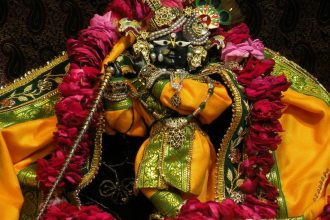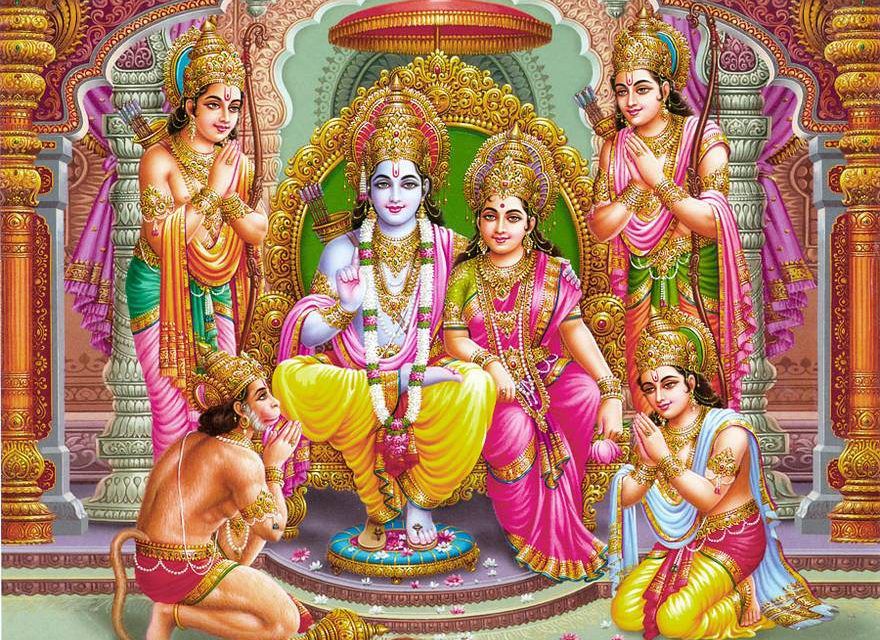- The assembled devotees should offer obeisances to Tulasī Devī with the Tulasī-praṇāma-mantra, which is chanted three times:
oṁ vṛndayai tulasī-devyai
priyāyai keśavasya ca
kṛṣṇa-bhakti-prade devī
satyavatai namo namaḥ
“I offer my repeated obeisances unto Vṛndā, Śrīmatī Tulasī Devi, who is very dear to Lord Keśava. O goddess, you bestow devotional service to Kṛṣṇa and you possess the highest truth.”
- The assembled devotees then recite the Tulasī-pūjā-kīrtana prayer in English:
“O Tulasī, beloved of Kṛṣṇa, I bow before you again and again. My desire is to obtain the service of Śrī Śrī Rādhā and Kṛṣṇa. Whoever takes shelter of you has his wishes fulfilled. Bestowing your mercy on him, you make him a resident of Vṛndāvana. My desire is that you will also give me a residence in the pleasure groves of Śrī Vṛndāvana-dhāma. Thus within my vision I will always behold the beautiful pastimes of Rādhā and Kṛṣṇa. I beg you to make me a follower of the cowherd damsels of Vraja. Please give me the privilege of devotional service and make me your own maidservant. This very fallen and lowly servant of Kṛṣṇa prays, “May I always swim in the love of Śrī Śrī Rādhā and Govinda.“
- Next, the devotees sing the Tulasī-pūjā-kīrtana song in Bengali:
namo namaḥ tulasī kṛṣṇa-preyasi namo namaḥ
rādhā-kṛṣṇa-sevā pābo ei abilāṣī
ye tomāra śaraṇa loy, tara vāñchā pūrṇa hoy
kṛpā kori’ koro tāre vṛndāvana-vāsi
mora ei abhilāṣa, vilāsa kuñje dio vāsa
nayana heribo sadā yugala-rūpa-rāśi
ei nivedana dhara, sakhīra anugata koro
sevā-adhikāra diye koro nīja dāsī
dīna kṛṣṇa-dāse koy, ei yena mora hoy
śrī-rādhā-govinda-preme sadā yena bhāsi
- As the song is sung, one of the devotees, acting as the priest or pūjārī, cleanses his hands and mouth. Then he offers Tulasī Devī incense, next the ghee lamp, and then flowers.
- When the song is finished, the devotees should walk or dance around Tulasī Devī at least four times. During the circumambulation, the following mantra is chanted:
yāni kāni ca pāpāni brahma-hatyādikāni ca
tāni tāni praṇaśyanti pradakṣiṇaḥ pade pade
- As the circumambulation is proceeding, one or more devotees should approach the Tulasī plant. One of them should, with his right hand, take the spoon from the water cup and, with water on it, pour the water on his right hand to cleanse it. (This may also be done for the devotee by the pūjārī.) One should then return the spoon to the cup. Then, using the right hand, one should take the spoon from the other cup and, with water on it, pour three drops on Tulasī Devī’s soil. This process should be followed by each devotee, one by one, while the other devotees are circling Tulasī Devī. After each devotee has watered the Tulasī plant, he should offer obeisances, reciting his guru-praṇati mantra. Then he should rise and stand to the side of the circling area or, if he wishes, continue to circumambulate Tulasī Devī.
- After the devotees have chanted the circumambulation mantra three times, they should proceed with a brief Hare Kṛṣṇa kīrtana. The circling of Tulasī may be continued during this kīrtana.
- When the kīrtana is finished, the devotees should again offer obeisances to Tulasī Devī with the Tulasī-praṇāma-mantra.
The Complete Tulasī Devī Worship
The following procedures are derived from the book Arcanā-paddhati, The Process of Deity Worship, which itself is an abridgement of the book Hari-bhakti-vilāsa by Sanātana Gosvāmī. Śrīla Bhaktisiddhanta Sarasvatī Gosvāmī Mahārāja commissioned the Arcanā-paddhati in order to regularize the worship in the temples he had established, and the book was compiled under his his order.
The following worship of Tulasī Devi should be performed by the Tulasī pūjārī after the morning worship of the other Deities is completed, or, if this is not possible, at another time during the morning.
- First one should recite the prayer:
nirmatā tvaṁ purā devair
arcitā tvaṁ surāsuraiḥ
tulasī hara me ‘vidyāṁ
pūjāṁ gṛhna namo ‘stu te
“O Śrīmatī Tulasī Devī, you were previously created by the demigods and worshiped by both them and the demons. O Śrīmatī Tulasī Devi, kindly take away my ignorance and accept my worship. I offer you my humble obeisances again and again.”
- Then, while sprinkling water on Śrīmatī Tulasī Devī, one should chant the following mantra:
oṁ govinda-vallabhāṁ devīṁ
bhakta-caitanya-kāriṇīm
snāpayāmī jagat-dhātrīṁ
kṛṣṇa-bhakti-pradāyinīm
“I am bathing goddess Tulasī Devī, who is very dear to Govinda and who brings life to all the devotees. She is the mother of the universe, and the bestower of devotion to Lord Kṛṣṇa.”
- Then, taking some arghya mixture (candana mixed with camphor, flower petals and water) from an arghya-pātra (a bowl) with a kuśī (spoon) and pouring some on her soil, one should chant:
śrīyaḥ śrīye śrīya-vāse
nityaṁ śrīdharaṁ sat-kṛte
bhaktyā dattaṁ mayā devi
arghyaṁ gṛhna namo ‘stu te
“O goddess Tulasī, I offer my obeisances unto you, who are the shelter and residence of all beauty and opulence. You are even worshiped by the Supreme Lord. O Tulasī, please accept this arghya water which is offered by me with devotion.”
- Then one should perform the following:
- a) One should offer a flower mixed with sandalwood pulp to Śrīmatī Tulasī Devī with the mantra:
- idaṁ sagandha-puṣpaṁ oṁ tulasyai namaḥ.
- b) One should offer the bath water of Śrī Kṛṣṇa to Tulasī Devī with the mantra:
- idaṁ śrī-kṛṣṇa-caraṇāmṛtaṁ om tulasyai namaḥ.
- c) One should offer garlands and flowers offered to the Lord with the mantra:
- idaṁ mahā-prasāda-nirmālyādikaṁ sarvaṁ oṁ tulasyai namaḥ.
- d) One should offer ācamana (water with ground nutmeg and cloves) to Śrīmatī Tulasī Devī with the mantra:
- idam ācamanīyaṁ oṁ tulasyai namaḥ.
- a) One should offer a flower mixed with sandalwood pulp to Śrīmatī Tulasī Devī with the mantra:
- Then one should sing the praise of Śrīmatī Tulasī Devī as follows:
mahā-prasāda-janani sarva-saubhāgya-vardhiṇi
ādhivyādhi-hare nityaṁ tulasī tvāṁ namo ‘stu te
“O Śrīmatī Tulasī Devī, I offer my repeated obeisances unto you. You are the mother of mahā-prasāda, the increaser of the good fortune of all, and you take away all diseases and anxieties.”
- Following this, one should offer obeisances to her with the Tulasī-praṇāma mantra:
oṁ vṛndayai tulasī-devyai
priyāyai keśavasya ca
kṛṣṇa-bhakti-prade devī
satyavatai namo namaḥ
“I offer my repeated obeisances unto Vṛndā, Śrīmatī Tulasī Devi, who is very dear to Lord Keśava. O goddess, you bestow devotional service to Kṛṣṇa and you possess the highest truth.”
- Then, with his right hand, one should very carefully, one by one, pick the Tulasī leaves or soft Tulasī-mañjarīs along with their stems while repeatedly uttering the Tulasī-cayana-mantra:
om tulasy amṛta-janmāsī sadā tvaṁ keśava-priyā
keśavārthaṁ cinomi tvāṁ varadā bhava śobhana
“O Tulasī, you are born from nectar. You are always very dear to Lord Keśava. Now, in order to worship Lord Keśava, I am collecting your leaves and mañjarīs. Please bestow your benediction on me to serve the Lord.”
It is best to remove only the older leaves near the stem, especially those she is about to release and which can be taken with a slight pull. Do not remove many leaves from a small plant, or she will suffer. All her leaves are offerable for worship, even dry, brown leaves. In an emergency, one may even offer pieces of her wood.
- Special care should be taken taken to ensure that no pain is caused to Śrīmatī Tulasī Devī, and, when one is finished, one should recite the kṣamā-prārthanā-mantra, begging her pardon:
cayanodbhava-duḥkhaṁ ca
yad hṛdi tava vartate
tat kṣamasva jagan-mātaḥ
vṛndā-devī namo ‘stu te
“O Tulasī Devī, I offer my respectful obeisances unto you. Kindly forgive me if I have caused you pain by picking your leaves and mañjarīs, O mother of the universe.”
Devotees are restricted from picking Tulasī leaves on dvādaśī (the twelfth day after a new or full moon), the day following ekādaśī. Even if Tulasī’s leaves have become dry due to having been cut on the previous day or cut in the morning, they may be used in Deity worship. Tulasī may be offered only to viṣṇu-tattva Deities, i.e., Kṛṣṇa, Balarāma, Lord Caitanya, etc.
Clipping and Storing Her Leaves and Mañjarīs
Clip the stalk below the first set of leaves at the base of the mañjarī or mañjarī unit (these may be small leaves) but as close as possible to the second set of leaves. When clipping, do not leave a small twig on her, as she will have to use energy to discard this now useless tissue. It is best to store the mañjarīs in large Tupperware containers so that they can “breathe” and not dry out. They should keep for several days.
In India, mañjarīs are broken off with the fingers of the right hand. Fingernails are not used. However, Westerners may have difficulty removing the mañjarīs cleanly, therefore a very small, sharp scissors, used only for Tulasī, is recommended. When making a Tulasī garland, never use a needle to pierce her. Instead, knot or wrap the thread around the mañjarīs.
Store the leaves in a bowl of fresh water or in plastic, airtight containers-and place them in the refrigerator. When using an airtight container, wash the leaves and pat them dry before placing them inside, as too much moisture will cause them to rot rapidly.
Eight Names of Śrīmatī Tulasī Devī
Vṛndāvanī: She who appears in Vṛndāvana forest.
Vṛndā: She who appears in many plants and trees.
Viśva-pūjitā: She who is worshiped in countless universes.
Puṣpasārā: The topmost of all flowers.
Nandinī: She who, when attained, brings faith and joy.
Kṛṣṇa-jīvanī: She who is the life of Lord Kṛṣṇa.
Viśva-pāvanī: She who purifies the whole universe.
Tulasī: She who is incomparable.
It is very auspicious to chant these eight names.













